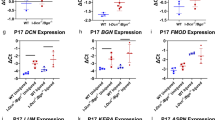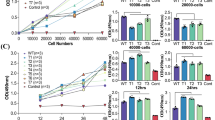Abstract
Herein, we investigate the high incidence of umbilical hernia and tippy-toe standing and their underlying changes in gene expression and proliferation in myostatin knockout (MSTN−/−) pigs. Thirty-six male MSTN−/− pigs were generated by somatic cell nuclear transfer (SCNT). These pigs presented a considerably high incidence of tippy-toe standing and umbilical hernia (69.4% and 61.1%, respectively). The tendon to body weight ratio was significantly lower than wild-type pigs (0.202 ± 0.017 vs 0.250 ± 0.004, respectively). The crimp length of the MSTN−/− tendon was significantly longer than that of wild-type pigs. The expression of MSTN and the activin type IIB (ACVR2B) was detected in the tendon and linea alba of MSTN−/− pigs. MSTN treatment significantly increased the phosphorylation of Smad2/3 in both tendon and linea alba fibroblasts. Type I collagen (Col1A) and Scleraxis (Scx) expression levels in the tendon and linea alba of MSTN−/− pigs were significantly lower than those in wild-type in vivo, whereas and cyclin-dependent kinase inhibitor 1 (p21) expression levels were higher. Treatment of tendon and linea alba fibroblasts with recombinant MSTN increased Col1A and Scx and decreased p21 expression in vivo. Moreover, there was a significant increase in fibroblast proliferation after treatment. The results indicated that MSTN regulates collagen expression and proliferation in tendon and linea alba fibroblasts; thus, MSTN deficiency causes collagen-related pathological features in MSTN−/− pigs. Hence, MSTN could be used as a therapeutic target for treating UH and tendon abnormalities.






Similar content being viewed by others
Data availability
The data that support the findings of this study are available from the corresponding author upon reasonable request.
References
Arthur P (1995) Double muscling in cattle: a review. Aust J Agric Res 46(8):1493–1515
Axer H, Keyserlingk DGV, Prescher A (2001) Collagen fibers in linea alba and rectus sheaths: I. General scheme and morphological aspects. J Surg Res 96(1):127–134
Benjamin M, Kaiser E, Milz S (2010) Structure-function relationships in tendons: a review. J Anat 212(3):211–228
Bertoli C, Skotheim JM, De Bruin RA (2013) Control of cell cycle transcription during G1 and S phases. Nat Rev Mol Cell Biol 14(8):518–528
Blumberg N (1980) Infantile umbilical hernia. Surg Gynecol Obstetr 150(2):187–192
Butler DL, Juncosa N, Dressler MR (2004) Functional efficacy of tendon repair processes. Annu Rev Biomed Eng 6:303–329
Caldwell FJ (2017) Flexural deformity of the distal interphalangeal joint. Vet Clin: Equine Pract 33(2):315–330
Chen B, Wang B, Zhang WJ, Zhou G, Cao Y, Liu W (2012) In vivo tendon engineering with skeletal muscle derived cells in a mouse model. Biomaterials 33(26):6086–6097
Cilley RE, Shereef S (2004) Umbilical hernia repair. Oper Tech Gen Surg 6(4):244–252
Diamant J, Keller A, Baer E, Litt M, Arridge R (1972) Collagen; ultrastructure and its relation to mechanical properties as a function of ageing. Proc R Soc Lond B Biol 180(1060):293–315
Dyson K (2015) Tippy toe troubles: regulars-horse therapy. Farmer’s Weekly 2015(15045):61
Elkasrawy M, Fulzele S, Bowser M, Wenger K, Hamrick M (2011) Myostatin (GDF-8) inhibits chondrogenesis and chondrocyte proliferation in vitro by suppressing Sox-9 expression. Growth Factors 29(6):253–262
Franz MG (2008) The biology of hernia formation. Surg Clin North Am 88(1):1–15
Fulzele S, Arounleut P, Cain M, Herberg S, Hunter M, Wenger K, Hamrick MW (2010) Role of myostatin (GDF-8) signaling in the human anterior cruciate ligament. J Orthop Res 28(8):1113–1118
Gartel AL (2005) Lost in transcription: p21 repression, mechanisms, and consequences. Can Res 65(10):3980–3985
Griffiths R (1991) Shortening of muscle fibres during stretch of the active cat medial gastrocnemius muscle: the role of tendon compliance. J Physiol 436(1):219–236
Gumucio JP, Davis ME, Bradley JR, Stafford PL, Schiffman CJ, Lynch EB, Claflin DR, Bedi A, Mendias CL (2012) Rotator cuff tear reduces muscle fiber specific force production and induces macrophage accumulation and autophagy. J Orthop Res 30(12):1963–1970
Harper JW, Adami GR, Wei N, Keyomarsi K, Elledge SJ (1993) The p21 Cdk-interacting protein Cip1 is a potent inhibitor of G1 cyclin-dependent kinases. Cell 75(4):805–816
Havis E, Bonnin M-A, Olivera-Martinez I, Nazaret N, Ruggiu M, Weibel J, Durand C, Guerquin M-J, Bonod-Bidaud C, Ruggiero F (2014) Transcriptomic analysis of mouse limb tendon cells during development. Development 141(19):3683–3696
Heinemeier KM, Olesen JL, Schjerling P, Haddad F, Langberg H, Baldwin KM, Kjaer M (2007) Short-term strength training and the expression of myostatin and IGF-I isoforms in rat muscle and tendon: differential effects of specific contraction types. J Appl Physiol 102(2):573–581
Herchenhan A, Kalson NS, Holmes DF, Hill P, Kadler KE, Margetts L (2012) Tenocyte contraction induces crimp formation in tendon-like tissue. Biomech Model Mechanobiol 11(3–4):449
Hirpara KM, Abouazza O, O’Neill B, O’Sullivan M (2006) A technique for porcine flexor tendon harvest. J Musculoskelet Res 10(04):181–186
Hodgson RJ, O’Connor PJ, Grainger AJ (2012) Tendon and ligament imaging. Br J Radiol 85(1016):1157–1172
Huang K, Shi XE, Wang J, Yao Y, Peng Y, Chen X, Li X, Yang G (2019) Upregulated microRNA-106a promotes porcine Preadipocyte proliferation and differentiation by targeting different genes. Genes 10(10):805
Junqueira LCU, Bignolas G, Brentani RR (1979) Picrosirius staining plus polarization microscopy, a specific method for collagen detection in tissue sections. Histochem J 11(4):447–455
Kang JD, Kim S, Zhu HY, Jin L, Guo Q, Li XC, Zhang YC, Xing XX, Xuan MF, Zhang GL (2017) Generation of cloned adult muscular pigs withmyostatin gene mutation by genetic engineering. RSC Adv 7(21):12541–12549
Kanisicak O, Mendez JJ, Yamamoto S, Yamamoto M, Goldhamer DJ (2009) Progenitors of skeletal muscle satellite cells express the muscle determination gene, MyoD. Dev Biol 332(1):131–141
Le W, Yao J (2017) The effect of myostatin (GDF-8) on proliferation and tenocyte differentiation of rat bone marrow-derived mesenchymal stem cells. J Hand Surg (Asian-Pacific Volume), 22(02):200–207
Leéjard V, Brideau G, Blais F, Salingcarnboriboon R, Wagner G, Roehrl MH, Noda M, Duprez D, Houillier P, Rossert J (2007) Scleraxis and NFATc regulate the expression of the pro-α1 (I) collagen gene in tendon fibroblasts. J Biol Chem 282(24):17665–17675
Leenhouwers JI, Merks J (2013) Suitability of traditional and conventional pig breeds in organic and low-input production systems in Europe: survey results and a review of literature. Anim Genet Resour 53:169–184
Livak KJ, Schmittgen TD (2001) Analysis of relative gene expression data using real-time quantitative PCR and the 2−ΔΔCT method. Methods 25(4):402–408
Luo ZB, Luo QR, Xuan MF, Han SZ, Wang JX, Guo Q, Choe Y-G, Jin SS, Kang JD, Yin XJ (2019) Comparison of internal organs between myostatin mutant and wild-type piglets. J Sci Food Agric 99(15):6788–6795
McPherron AC, Lawler AM, Lee S-J (1997) Regulation of skeletal muscle mass in mice by a new TGF-p superfamily member. Nature 387(6628):83–90
Mendias CL, Bakhurin KI, Faulkner JA (2008) Tendons of myostatin-deficient mice are small, brittle, and hypocellular. Proc Natl Acad Sci 105(1):388–393
Mendias CL, Lynch EB, Gumucio JP, Flood MD, Rittman DS, Van Pelt DW, Roche SM, Davis CS (2015) Changes in skeletal muscle and tendon structure and function following genetic inactivation of myostatin in rats. J Physiol 593(8):2037–2052
Pryce BA, Brent AE, Murchison ND, Tabin CJ, Schweitzer R (2007) Generation of transgenic tendon reporters, ScxGFP and ScxAP, using regulatory elements of the scleraxis gene. Dev Dyn 236(6):1677–1682
Sala DA, Shulman LH, Kennedy RF, Grant AD, Chu MLY (1999) Idiopathic toe-walking: a review. Dev Med Child Neurol 41(12):846–848
Salabi F, Nazari M, Chen Q, Nimal J, Tong J, Cao WG (2014) Myostatin knockout using zinc-finger nucleases promotes proliferation of ovine primary satellite cells in vitro. J Biotechnol 192:268–280
Schweitzer R, Chyung JH, Murtaugh LC, Brent AE, Rosen V, Olson EN, Lassar A, Tabin CJ (2001) Analysis of the tendon cell fate using Scleraxis, a specific marker for tendons and ligaments. Development 128(19):3855–3866
Si Z, Bhardwaj R, Rosch R, Merten PR, Klosterhalfen B, Klinge U (2002) Impaired balance of type I and type III procollagen mRNA in cultured fibroblasts of patients with incisional hernia. Surgery 131(3):324–331
Thomas M, Langley B, Berry C, Sharma M, Kirk S, Bass J, Kambadur R (2000) Myostatin, a Negative Regulator of Muscle Growth, Functions by Inhibiting Myoblast Proliferation. J Biol Chem 275(51):40235–40243
Wood JD, Richardson RI, Nute GR, Fisher AV, Campo MM, Kasapidou E, Sheard PR, Enser M (2004) Effects of fatty acids on meat quality: a review. Meat Sci 66(1):21–32
Xiong Y, Hannon GJ, Zhang H, Casso D, Kobayashi R, Beach D (1993) p21 is a universal inhibitor of cyclin kinases. Nature 366(6456):701–704
Yang G, Rothrauff BB, Tuan RS (2013) Tendon and ligament regeneration and repair: clinical relevance and developmental paradigm. Birth Defects Res C Embryo Today 99(3):203–222
Yang W, Zhang Y, Li Y, Wu Z, Zhu D (2007) Myostatin Induces Cyclin D1 Degradation to Cause Cell Cycle Arrest through a Phosphatidylinositol 3-Kinase/AKT/GSK-3β Pathway and Is Antagonized by Insulin-like Growth Factor 1. J Biol Chem 282(6):3799
Yin XJ, Tani T, Yonemura I, Kawakami M, Miyamoto K, Hasegawa R, Kato Y, Tsunoda Y (2002) Production of cloned pigs from adult somatic cells by chemically assisted removal of maternal chromosomes. Biol Reprod 67(2):442–446. https://doi.org/10.1095/biolreprod67.2.442
Zheng H, Si Z, Kasperk R, Bhardwaj RS, Schumpelick V, Klinge U, Klosterhalfen B (2002) Recurrent inguinal hernia: disease of the collagen matrix? World J Surg 26(4):401–408
Zhu XX, Zhong YZ, Ge YW, Lu KH, Lu SS (2018) CRISPR/Cas9-mediated generation of Guangxi Bama minipigs harboring three mutations in α-synuclein causing Parkinson’s disease. Sci Rep 8(1):1–11
Acknowledgements
The authors thank all the staff at the Longxing Pig Farm (Longjing, China) for their assistance with feeding and care of the animals.
Funding
This work was supported by the National Natural Science Foundation of China (No. 31860297).
Author information
Authors and Affiliations
Contributions
All authors contributed to the writing, review, and editing. H.-J. Paek contributed to conception and design of the study, writing of the manuscript; H.-J. Paek and Z.-B. Luo collected the field samples; H.-M. Choe, K. Gao, S.-Z. Han, and Z.-Y. Li performed experiments and collected the data; J.-D. Kang and B.-H. Quan analyzed the data statistically; X.-J. Yin provided regarding supervision and funding support. All authors approved the final version of the manuscript.
Corresponding author
Ethics declarations
Conflict of interest
The authors have no conflicts of interest to declare.
Additional information
Publisher's Note
Springer Nature remains neutral with regard to jurisdictional claims in published maps and institutional affiliations.
Rights and permissions
About this article
Cite this article
Paek, HJ., Luo, ZB., Choe, HM. et al. Association of myostatin deficiency with collagen related disease-umbilical hernia and tippy toe standing in pigs. Transgenic Res 30, 663–674 (2021). https://doi.org/10.1007/s11248-021-00275-6
Received:
Accepted:
Published:
Issue Date:
DOI: https://doi.org/10.1007/s11248-021-00275-6




